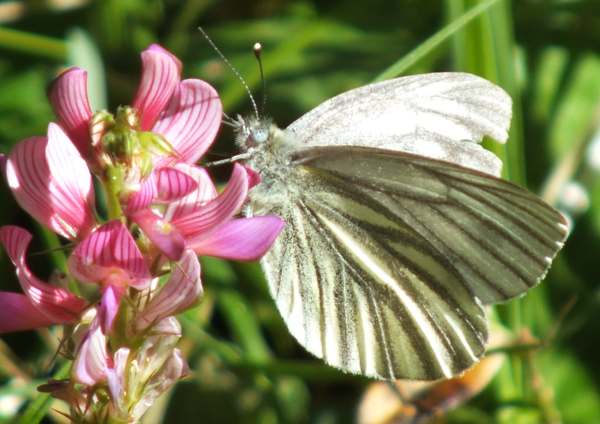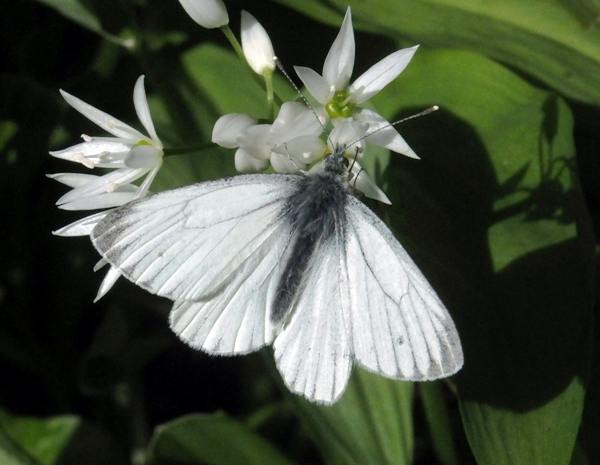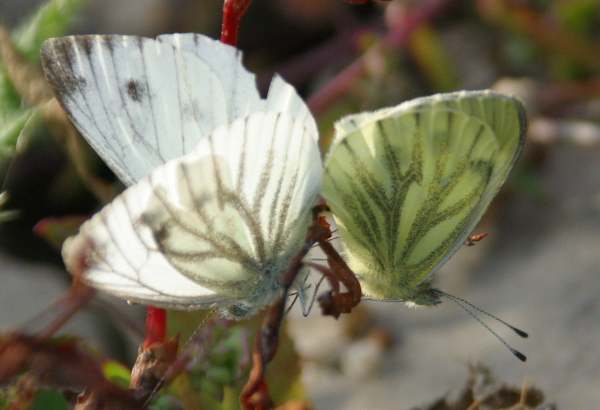Green-veined White Butterfly - Pieris napi
Phylum: Arthropoda - Class: Insecta - Order: Lepidoptera - Family: Pieridae

Seen from the top, the Green-veined White butterfly could easily be mistaken for a Small White; however, the characteristic greeny-grey veins on the underside of the wings are an easy means of identification. The wingspan varies between 4.5 and 5.5cm.

Above: The upperwings of this first-brood Green-veined White (seen on Ransoms, or Wild Garlic) are whiter than those of later brood aduts.
The females have two dark-grey spots on the upper side of each forewing, while the males have just one dark spot and grey tips on their forewings.
Distribution
Apart from the Shetlands and some parts of the Scottish Highlands, this butterfly is common and widespread throughout Britain and Ireland. Elsewhere, its range extends throughout most of mainland Europe.

Above: A Green-veined White in the Ardeche region of France
Lifecycle
The eggs are laid on the undersides of larval foodplants which, as with so many white butterflies are mainly members of the family Brassicaceae, including Cuckooflower, Garlic Mustard, Wild Cabbage and Wild Radish. The Orange Tip Butterfly often uses the same plant as the Green-veined White but as the two species consume different parts of the host plant they are not in competition for food. Orange Tip caterpillars do not eat the leaves, whereas Green-veined White caterpillars eat only the leaves and do not touch the flower stems, petals or seed capsules that are the staple diet of the Orange Tips.

The eggs take about a week to hatch, depending on the weather, and then the green caterpillars take a month or thereabouts to grow full size, moulting four times in the process; then they pupate, a stage that lasts about ten days (unless overwintering) before the adult butterfly emerges.
Most years the Green-veined Whites have two or even three broods, and so they can be seen in flight from March right through until October. Other than the open-winged specimen on Ransoms, tthe butterflies in the butterflies shown on this page were photographed in West Wales in early August.
Acknowledgements
This page includes pictures kindly contributed by Betty and Tony Rackham.
Studying butterflies and moths...
Excited at the prospect of flyfishing? So are we, and we're pretty sure you would find the Winding River Mystery trilogy of action-packed thrillers gripping reading too. Dead Drift, Dead Cert, and Dead End are Pat O'Reilly's latest river-and-flyfishing based novels, and now they are available in ebook format. Full details on our website here...
Buy each book for just £4.96 on Amazon...
Please Help Us: If you have found this information interesting and useful, please consider helping to keep First Nature online by making a small donation towards the web hosting and internet costs.
Any donations over and above the essential running costs will help support the conservation work of Plantlife, the Rivers Trust and charitable botanic gardens - as do author royalties and publisher proceeds from books by Pat and Sue.
